If you’ve wanted to learn how to make yogurt, you’ll be surprised at how easy it really is! This recipe yields a thick and creamy yogurt, and provides tips so it will come out exactly as you like it.
Making the transition from flavored to plain yogurt was one of the best things I did for my diet. I am lactose intolerant, but yogurt has a greatly reduced lactose content because the milk sugars (lactose) are digested by the bacteria in the fermenting process. Yogurt is a great source of calcium and protein for me and other’s who are lactose intolerant.
For years, I bought flavored yogurt and ate it every day. When I was trying to cut sugar out of my diet, I realized how much sugar was in one of those little cups. One serving of fruit flavored yogurt can easily have the recommended 4 teaspoons of sugar a day. I don’t know about you, but if I am going to eat added sugar, I want it in cookie form.
When I started eating plain yogurt, I didn’t start eating it straight up plain. I added frozen bananas, nut butter, and a drizzle of honey or blackstrap molasses. The teaspoon of honey or 1/2 teaspoon of molasses was less sugar than the processed refined stuff in my old yogurt, plus I enjoyed it more– real food, right? Always tastes better.
As I got used to the taste of plain yogurt, I stopped adding the honey and molasses. I still add frozen banana often, because it makes it ice-cream like, and who doesn’t want that?
I actually add chopped dark chocolate, unsweetened coconut, and walnuts, too. And fruit.
Since cutting out flavored yogurt, my tastes have changed, and I now almost never add sugar to anything. The less sugar you consume, the less sugar your taste buds need – this was really evident when I started baking low sugar. “Regular” baked goods now taste intolerable to me – so sweet they almost burn. Cutting out something you regularly consume that has added sugar, like yogurt, can really have an impact on your tolerance level.
Contents
Why Learn How to Make Yogurt?
We go through a lot of yogurt in our house. Buying organic plain yogurt can get expensive. One quart of yogurt is the same cost as a gallon of organic milk. 4 quarts = 1 gallon, which means you can make organic, whole milk yogurt for 1/4 the cost of buying it.
That’s a lot of savings in our house, where we easily go through 4 quarts of yogurt in a week. We use it in smoothies, and almost every night on top of fruit as our dessert. And sometimes we even eat it for breakfast, too.
When I decided to take the plunge and learn how to make yogurt, I was looking at buying a yogurt maker. All a yogurt maker is is a food-grade plastic container with a thermal layer (a double wall) around it. It’s purpose is to tightly seal to allow fermentation, and to keep the yogurt at 110 degrees throughout the process, which takes 4-12 hours.
Some people use a cast iron dutch oven, and then place it inside their oven for insulation.
I found this lurking in the back of one of my cupboards, and knew it was the perfect yogurt maker. Saved me $20. And breathed life back into something we hadn’t used for years. All about recycling!
You also need a thermometer. I went out looking for a candy thermometer, and couldn’t find one. I started to order one online, and meat thermometers came up in the search results- reminding me I had a BBQ meat thermometer- and it works perfect. Another $15 saved in this venture.
I bet if you take a look through your kitchen, you can find stand ins for these two needed tools.
Tips for How to Make Yogurt
- Find the right equipment:
- Yogurt Maker: You can buy a yogurt maker, if you don’t have anything in your kitchen you can repurpose. I use an old thermos and it’s perfect. You need an airtight seal, and you need to keep the mixture at a consistent temperature (at least mostly, a little heat loss is okay).
- Thermometer: You can use a candy thermometer, or a meat thermometer. If you don’t have one you can use, order the one you will use the most often. I don’t make candy, so I wouldn’t waste money on that. I do BBQ, so that’s a better option for me.
- Whisk and Saucepan: The most important thing to remember about these items is that you want them very clean. Whatever bacterias you introduce to your milk will grow during the fermentation process- whether it’s the gut healthy yogurt cultures you add, or the nasty bacteria your toddler picked up at preschool. My son loves to play with my whisk, so prior to making yogurt, I make sure everything has been washed, and then I pour boiling water over my whisk, the pan, and the yogurt maker. Pulling these items out of your dishwasher should be fine.
- Choose a Milk:
- Ultra Pasturized milk cannot be used for making yogurt. It has been heated past 212 degrees. If milk is heated beyond this point, it will not culture.
- Raw milk can be used, but it will result in a thinner yogurt (I have never tried this, so read more about it if you want to use raw milk).
- I use organic milk, especially when I know my son will be eating it. I want to make sure I am avoiding growth hormones. Regardless of whether they have been proven to be harmful, I would MUCH rather than safe than sorry when it comes to my family.
- If you want to use a dairy-free alternative, the process is slightly different, but it is possible. I will be posting on this soon!
- Choose a Yogurt to use as a starter: Choose a yogurt you enjoy eating, because it will impact the taste of your homemade yogurt. For the best quality, choose a yogurt that has more than 1 bacteria species, since they have different benefits to gut health. For example, a yogurt might contain just “S. thermophilus,” or might contain “S. thermophilus, L. bulgaricus, L. acidophilus and L. casei.” In general, the more bacteria, the better. After your first batch, you can use your homemade yogurt as a starter in your 2nd and subsequent batches.
- Make it Thicker: There are multiple ways to make the yogurt thicker:
- A 2-3 tablespoons non-fat milk powder to the milk prior to heating it. I tried this but found it unnecessary.
- Some people add gelatin. I haven’t experimented with this yet, but will, because there are many health benefits to eating grass-fed, high quality gelatin.
- Strain it – Greek yogurt is simply yogurt that has been strained of whey. To do this, just line a strainer with a paper towel (a coffee filter will work too), and place the strainer on top of a bowl. Add your yogurt to the lined strainer, and leave it in the fridge for 1 hour to overnight. The longer you strain it, the more whey (see the clear liquid in the bowl below) will drain out. You don’t need to throw out the strained whey – find ideas to use it here.
- Lower the Calories: I find that eating whole milk yogurt is a lot more satisfying than low-fat or non-fat varieties, so I eat less of it. If you would prefer making it with low fat milk, add a few tablespoons of non-fat powdered milk to your milk prior to heating. I found that adding it after heating the milk resulted in a lot of lumps. I used 3 tablespoons of milk powder mixed into low fat milk, and the result was almost as thick as the whole milk yogurt.
- For the Family: If your family is not used to unflavored/unsweetened yogurt, plain yogurt might be too sour. Feel free to add honey or other sweeteners you use with for family after the yogurt has cooled. However, if you are looking on eliminating or reducing added sugars from your family’s diets, try just serving plain yogurt with fresh fruit. Possibly even start with just a drizzle of honey or blackstrap molasses on top. If you mix the sweetener in, you will end up needing more. When I switched to unsweetened yogurt, I used one of those, and after I was used to the plain yogurt, I stopped adding anything and now just use fruit.
I’d love to connect with you on social media! Find me on Facebook or Instagram where I post daily healthy eating and lifestyle inspiration.
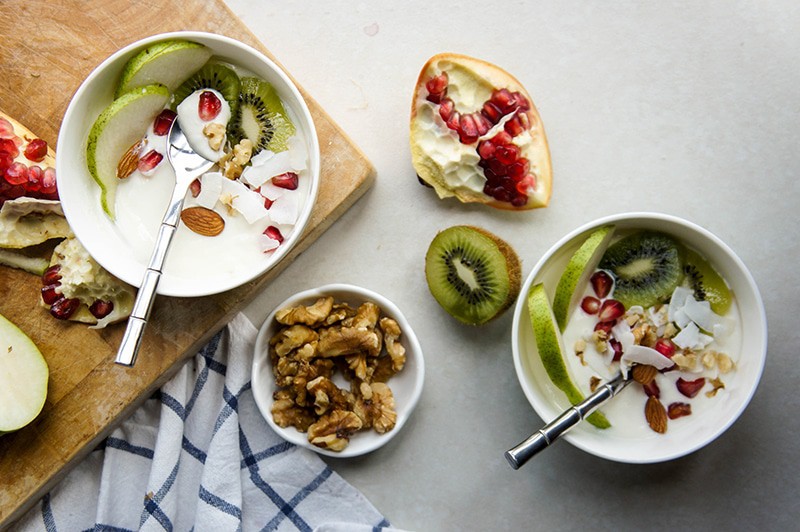
How to Make Yogurt
Ingredients
- 1 quart organic whole milk
- 1/2 cup organic yogurt*
Instructions
- Add milk to a saucepan, and bring to 210 degrees Fahrenheit over medium-high heat. Whisk milk often to keep from burning.Add milk to a saucepan, and bring to 210 degrees Fahrenheit over medium-high heat. Whisk milk often to keep from burning.
- Remove milk from heat, and allow to cool to 110 degrees Fahrenheit. If milk cools below this temperature, don't worry. Just reheat it gently until it reaches 110 degrees again.Remove milk from heat, and allow to cool to 110 degrees Fahrenheit. If milk cools below this temperature, don't worry. Just reheat it gently until it reaches 110 degrees again.
- The milk should never boil. The milk should never boil.
- In a small (very clean) bowl, add 1/2 cup of yogurt and 1/2 cup of heated milk, and whisk together until smooth. Add yogurt mixture to the milk pan, and whisk until it is mixed well.In a small (very clean) bowl, add 1/2 cup of yogurt and 1/2 cup of heated milk, and whisk together until smooth. Add yogurt mixture to the milk pan, and whisk until it is mixed well.
- Pour milk mixture into a yogurt maker (see options above recipe in post).Pour milk mixture into a yogurt maker (see options above recipe in post).
- Allow yogurt to ferment for 4-12 hours. When making your first few batches, check the thickness and sourness at 4 hours. The longer it ferments, the more sour and thick it will become. Mine is perfect at 5-6 hours, but there are a lot of factors that influence this, including how warm your yogurt stays during fermentation.llow yogurt to ferment for 4-12 hours. When making your first few batches, check the thickness and sourness at 4 hours. The longer it ferments, the more sour and thick it will become. Mine is perfect at 5-6 hours, but there are a lot of factors that influence this, including how warm your yogurt stays during fermentation.
- See the tips above for more ideas on making your perfect yogurt.See the tips above for more ideas on making your perfect yogurt.
Notes
Nutrition
This post contains affiliate links, which means that if you click on one of the product links, I’ll receive a small percentage of any purchases made.
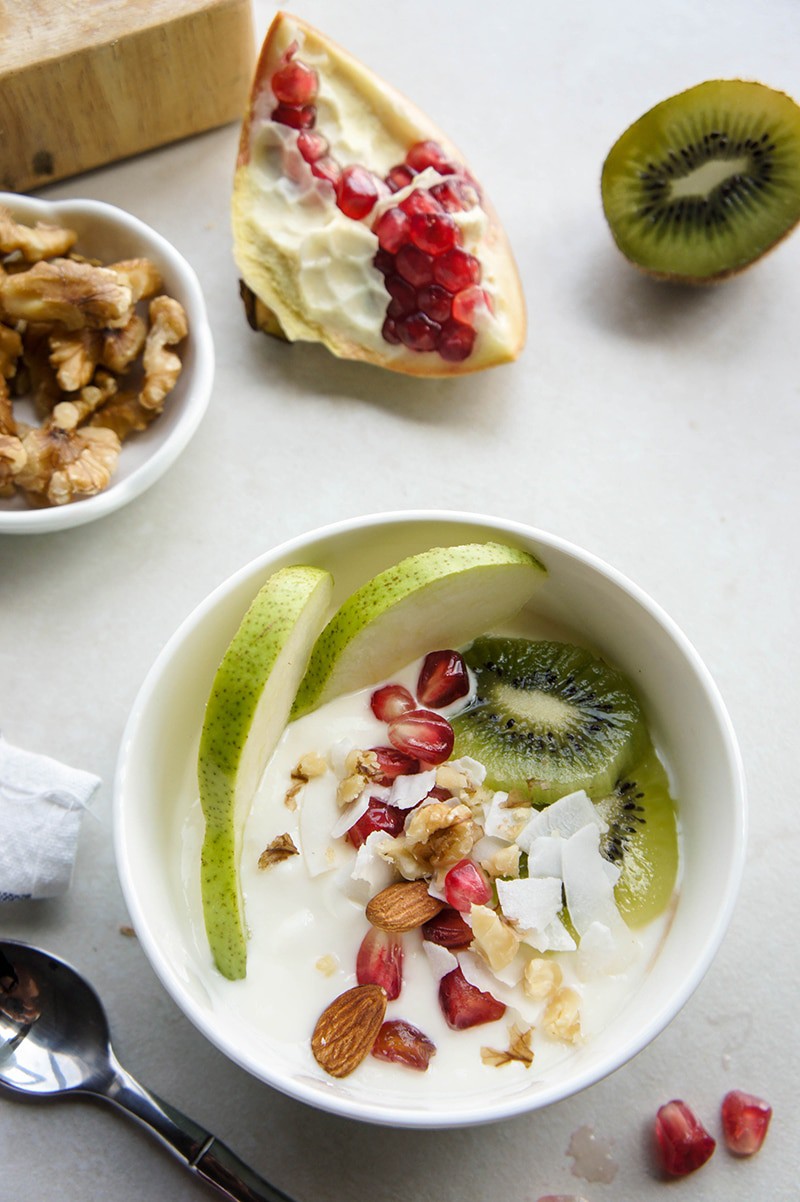
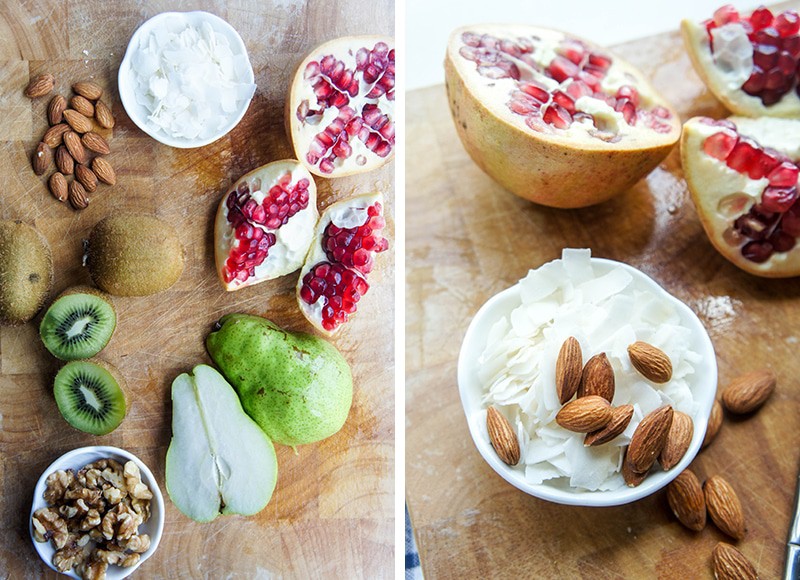
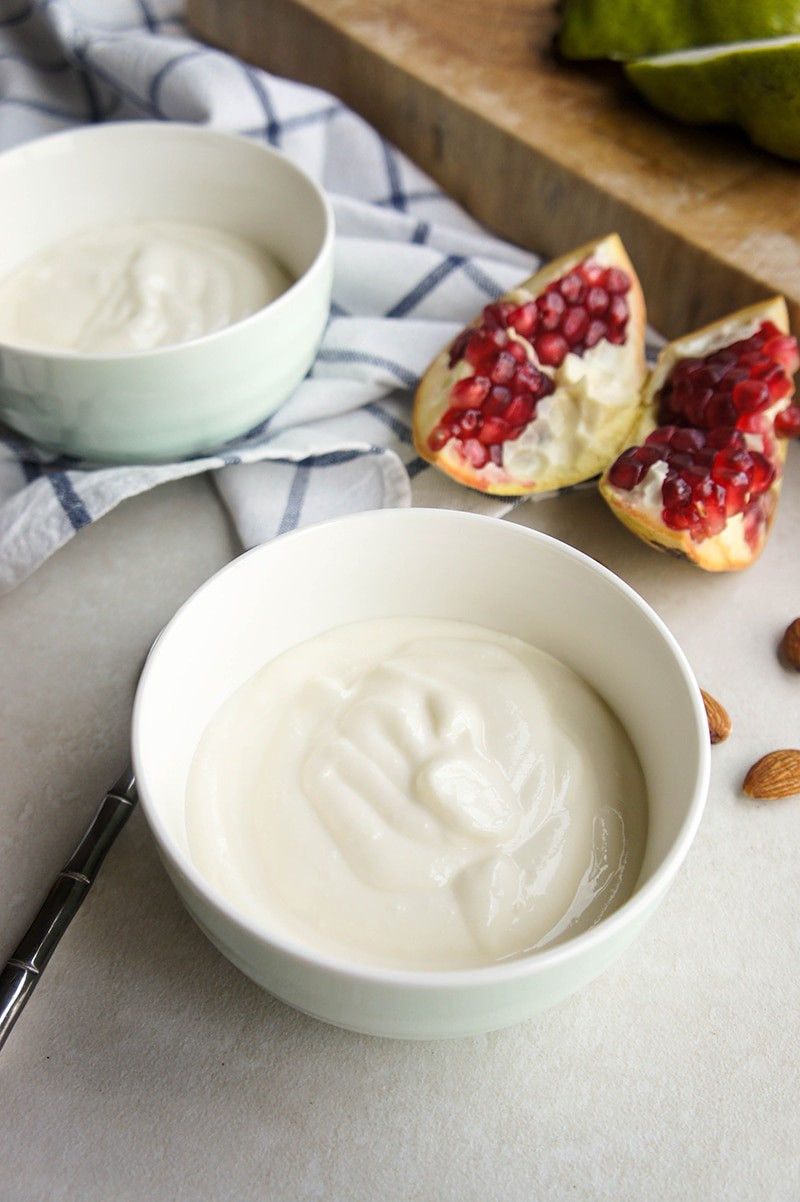
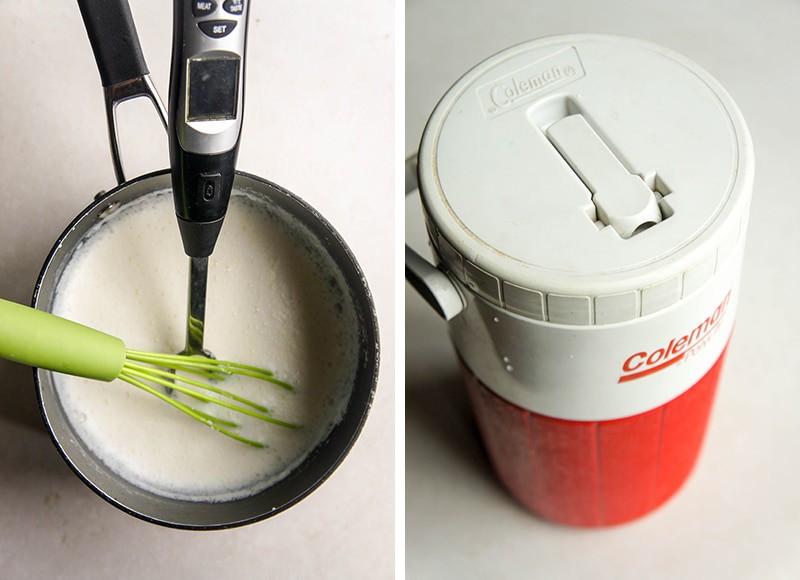
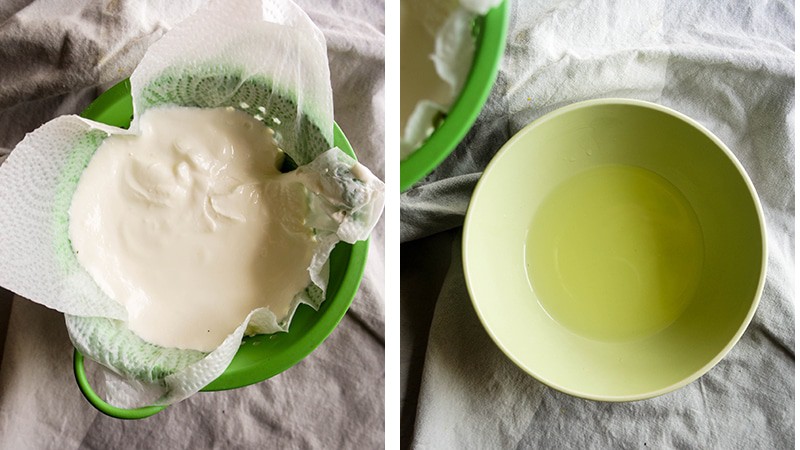
Ahhh! On my bucket list to work on (but vegan of course!)
I’m working on a cashew coconut vegan one 🙂
I always buy organic natural yoghurt so you are very right that it is expensive. I’ve been meaning to try making my own but never get around to it. I am definitely going to give it a try and follow your instructions. It doesn’t sound too difficult at all.
I also always buy unhomogenized milk, I wonder if that would be appropriate to make yoghurt?
You really should– it’s so easy! I did read about using non-homogenized milk ,but haven’t tried it. I read it’s fine, but the cream will separate from the yogurt just like it does from the milk. You will just need to stir it back in 🙂 Good luck!
This seems so easy but I just don’t think it’s something I could ever do successfully.
If you can read a thermometer, you can make yogurt 🙂
I am a plain yogurt fan too, there is just so many things we can throw in to add flavor! This bowl looks delicious, can’t wait to try the recipe.
Yes, I love adding so many different things to my yogurt. I actually prefer it to going out and getting frozen yogurt now– whenever I get fro yo, it’s too sweet, and I miss my frozen banana 🙂
Wow I’ve never thought of making homemade yogurt before but it sounds so fun, I really want to give it a go now!!
It’s ridiculously easy, Emily! We eat so much I make it 3 times a week, but it’s no big deal. I just start it while I am going something else in the kitchen, and then it sits around and turns into yogurt over the next 4-8 hours. Simple!
I have never attempted to make yogurt. We have it in the house all the time. Looks intriguing. Perhaps this will have to be an experiment to try after the holidays!!
I use yogurt to make a lot of desserts- in place of cream cheese or cream. Healthier 🙂 So I need to make it during the holidays to save $!
I’ve never tried to make my own yogurt, I bet it’s super delicious!
I hardly buy yogurt and I have been making yogurt since years. No kidding.
Perfect timing! I don’t have a yogurt maker and wanted so much to tey making yogurt myself. Pinning!!!!
Thanks Claudia– a yogurt maker is just a glorified insulated container– anything will work!
You can get a yogurt maker during Black Friday for way cheaper. I got mine a few weeks for 30% off!
I love using the thermos– it was something I never used for anything else and it works great.
I am excited to try this out. Great way to get pure and an organic dairy breakfast base!